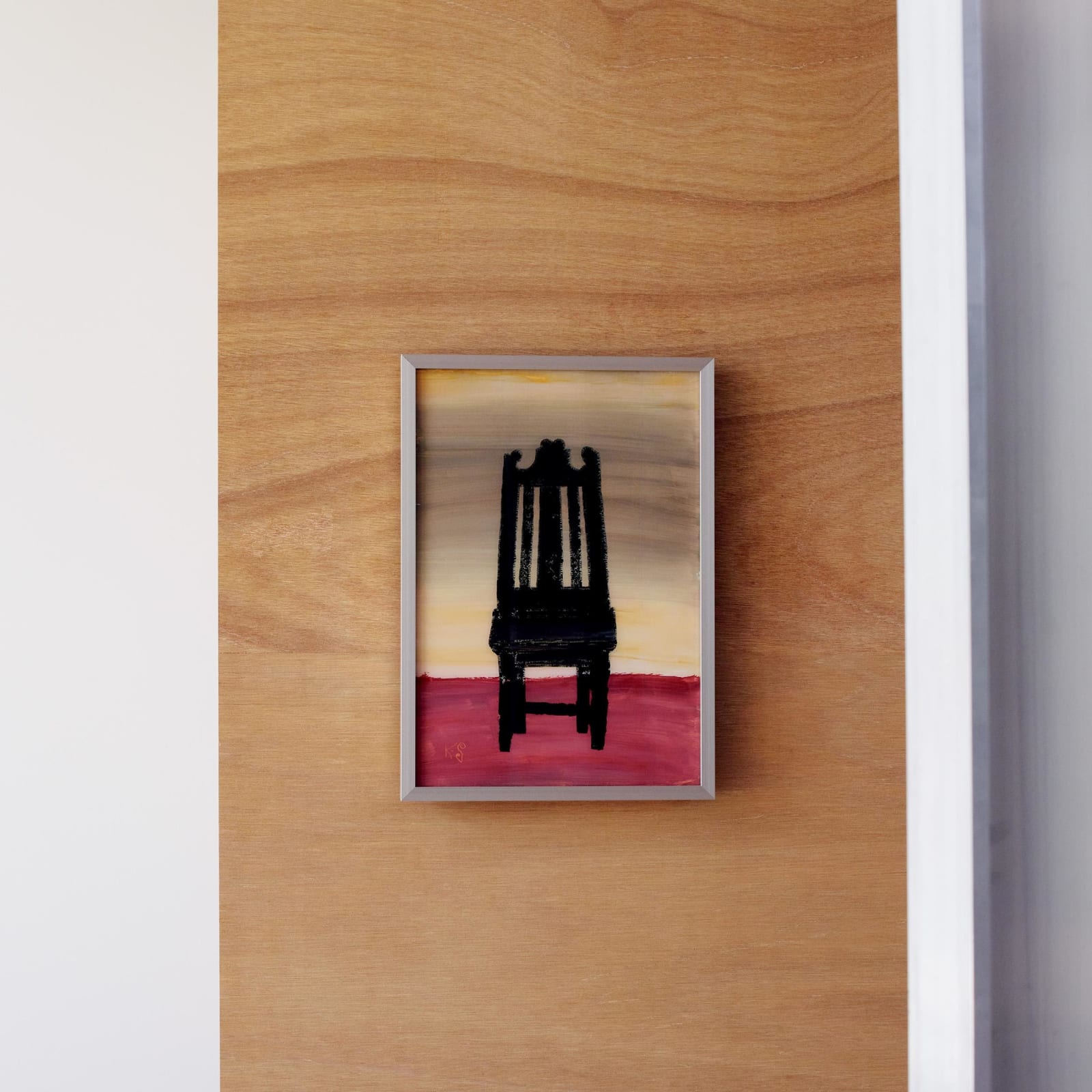Serizawa Keisuke (1895–1984)
Chair
Glass painting, framed
With a label signed by the artist
39.5 x 27.5 cm
41 x 29 cm (overall)
With a label signed by the artist
39.5 x 27.5 cm
41 x 29 cm (overall)
Further images
The title ‘chair’ in kanji characters are written on the back of this piece alongside the first syllable of his family name ‘se’ inside a regular hexagon, and the kanji characters for ‘Keisuke,’ the artist’s name. The chair’s black painted surface hints at why this work was created as a glass painting. A closer look reveals several cracks on the chair’s rough wooden surface. The reason for the painting’s existence is found in this expression of cracks and scratches on wood. It seems Serizawa was driven by the enjoyable challenge of using the bleeding that permeates a glass painting to represent the various cracks that form on a wood surface over time.
After making a rough sketch, he applied a bright gray color scheme to the chair’s outline, with the gray flowing outward from the center to form the painting’s ground. He then completed the work using black paint.
Serizawa Keisuke began stencil dyeing in 1930 and he continued working with the technique for over 50 years, right until his final years. When Yanagi Muneyoshi founded the Japan Folk Crafts Museum in 1936, Serizawa joined him on a survey of folk crafts, and he also helped put together the museum’s collection. After being designated a Living National Treasure in 1956 for his ‘kataezome’ stencil dyeing technique, Serizawa set up his own dyeing studio. He remained a passionate collector thereafter too. He collected around 40 chairs from Europe, Africa and elsewhere. This painting emerged from his observations of these collected chairs. Serizawa’s glass paintings are said to date from 1936 or 1937, but many of his glass paintings of chairs date from 1975 or later. It could be presumed that the collection of chairs began around this time. His initial chair works involved comparisons of Italian and Spanish chairs, for example, or an array of children’s chairs from each country. He then began painting chairs laden with books, cloth and other objects. In his later paintings, it seems he wanted to express the sense of presence of the chairs themselves by focusing on the pattern and cut of their wood grain or, like with this work, on the wood’s many cracks and scratches.
Serizawa Keisuke (dyer; 1895–1984)
Dyer from Shizuoka Prefecture. Because of his friendship with Yanagi Muneyoshi (Soetsu), Serizawa helped to design the cover for Yanagi’s curated folk craft magazine Kogei. Through Kogei, he introduced the technique of “kataezome” (stencil dyeing), which enhanced his communication with participants of the Mingei movement. He also got involved in the design of interior and exterior spaces as well as furniture for the Japan Folk Crafts Museum and Ohara Museum of Art in Kurashiki. He was a recipient of the Cultural Merit Award and the holder of Intangible Cultural Property for his expertise in kataezome dyeing.
After making a rough sketch, he applied a bright gray color scheme to the chair’s outline, with the gray flowing outward from the center to form the painting’s ground. He then completed the work using black paint.
Serizawa Keisuke began stencil dyeing in 1930 and he continued working with the technique for over 50 years, right until his final years. When Yanagi Muneyoshi founded the Japan Folk Crafts Museum in 1936, Serizawa joined him on a survey of folk crafts, and he also helped put together the museum’s collection. After being designated a Living National Treasure in 1956 for his ‘kataezome’ stencil dyeing technique, Serizawa set up his own dyeing studio. He remained a passionate collector thereafter too. He collected around 40 chairs from Europe, Africa and elsewhere. This painting emerged from his observations of these collected chairs. Serizawa’s glass paintings are said to date from 1936 or 1937, but many of his glass paintings of chairs date from 1975 or later. It could be presumed that the collection of chairs began around this time. His initial chair works involved comparisons of Italian and Spanish chairs, for example, or an array of children’s chairs from each country. He then began painting chairs laden with books, cloth and other objects. In his later paintings, it seems he wanted to express the sense of presence of the chairs themselves by focusing on the pattern and cut of their wood grain or, like with this work, on the wood’s many cracks and scratches.
Serizawa Keisuke (dyer; 1895–1984)
Dyer from Shizuoka Prefecture. Because of his friendship with Yanagi Muneyoshi (Soetsu), Serizawa helped to design the cover for Yanagi’s curated folk craft magazine Kogei. Through Kogei, he introduced the technique of “kataezome” (stencil dyeing), which enhanced his communication with participants of the Mingei movement. He also got involved in the design of interior and exterior spaces as well as furniture for the Japan Folk Crafts Museum and Ohara Museum of Art in Kurashiki. He was a recipient of the Cultural Merit Award and the holder of Intangible Cultural Property for his expertise in kataezome dyeing.





